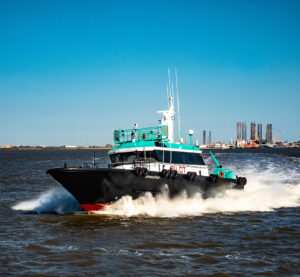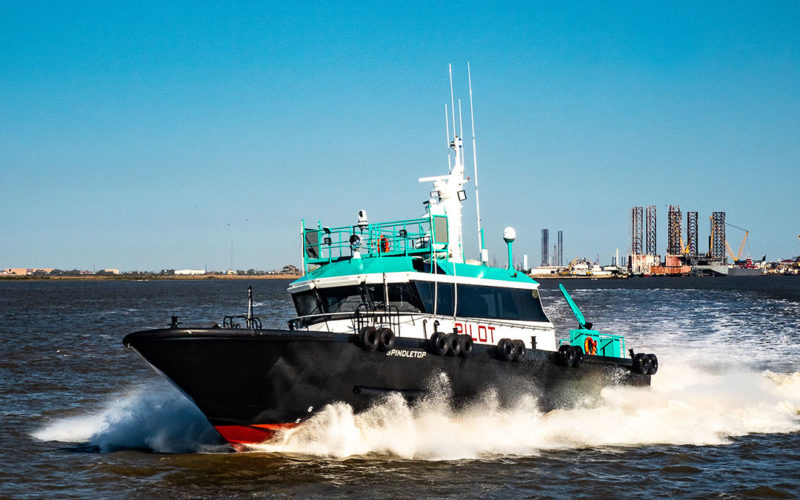
Oil has fueled the Texas economy since the Spindletop field near Beaumont began gushing at a rate of 100,000 barrels per day in 1901.
This year, Breaux’s Bay Craft of Loreauville, La., delivered Spindletop, a 90-foot pilot boat, to the Sabine Pilots of Port Arthur, Texas. Spindletop was conceived and built to keep pace with growth in the petroleum trade, including liquefied natural gas (LNG), in the Sabine-Neches Waterway.
The waterway is being expanded in large part to handle an increase in tanker traffic at the region’s ports. The Sabine Pilots needed a larger and faster boat with the ability to transport up to 14 pilots quickly over an additional 14 miles being tacked on to the current 20-mile transit to the sea buoy.
On a March morning, Leslie Tucker, port captain for the Sabine Pilots, guided Spindletop through Sabine Pass into a 3-foot sea in the Gulf of Mexico. The newbuild — the largest all-aluminum pilot boat in the United States — has a deep-V hull developed by Breaux’s Bay Craft that knifes through waves. Humphree Interceptor trim tabs provide extra stability and motion control.
The four pilots aboard, headed for ships anchored at the sea buoy, were comfortably ensconced in Norsap gas-spring chairs, of which there are 15 in the pilothouse. Boat operator Dylan Simmons, who was monitoring ship traffic, sat on the port side of the forward control console. Tucker, in a Norsap captain’s chair equipped with a boatload of features, brought the vessel up to 27 knots.
“Really there’s nothing I don’t like about this boat,” said Tucker, who joined the Sabine Pilots on deck 32 years ago. “I especially like the fuel efficiency, the electronics, the FLIR camera and the creature comforts.”
Simmons echoed the comment and said, “The other day we made 20 knots in a 9-foot sea and the ride was very comfortable.”
Spindletop is awash in safety features, comforts and advanced equipment. There are boarding platforms port and starboard forward of the pilothouse, with two more platforms on the cabin top. The roof is also fitted with a FLIR thermal-imaging camera. The electronics in the pilothouse could serve as a mobile Furuno showroom.
Other nods to safety include LED lighting that adds protection during night operations, as well as a Harken tight radius rail system for pilots and crew walking outside the pilothouse while underway. For relaxation, there are two double-bunk staterooms below deck.
The propulsion chain consists of four 800-hp Scania diesel engines coupled to Twin Disc reduction gears shafted to HamiltonJet waterjets.
Capt. Ken Hurd, boat superintendent, has high praise for the newbuild. He is especially satisfied with the safety features and the comfort the boat provides for the long transits out to the sea buoy, and the capabilities it brings to pilotage for the future.

